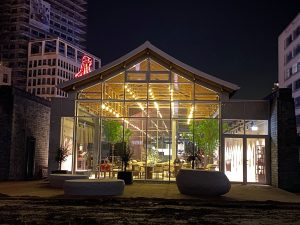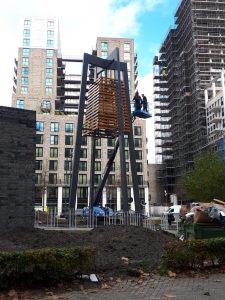Chinees paviljoen op Strijp-S te Eindhoven

| Category | Commercial Projects |
|---|---|
| Year | 2022 |
| Country | Benelux |
| Organization | Da Silva Tekenbureau |
| Project partners | Stam & de Koning Eindhoven - Aarts Constructiewerken Veldhoven B.V |
| Author | Sergio Pontes da Silva |
| Co-authors | Architect: Jiazuo Hou |
| Client | Van Asperddt Onderhoud & Beheer en Aarts Constructiewerken Veldhoven B.V. |
| Place of construction | Strijp-S Te Eindhoven |
| Tags |
‘You Ning’
Het gebouw bij de entree van Strijp-S is een geschenk van de Eindhovense zusterstad Nanjing in China. Eindhoven kreeg het al in 2005, toen het twintigjarig bestaan van de stedenband met Nanjing werd gevierd. De naam You Ning verwijst volgens Eveline Wu naar vriendschap (‘You’) en een afkorting van de stadsnaam Nanjing (‘Ning’). In overleg met de Chinese gulle gever is gekozen voor moderne architectuur. De robuuste stenen muren aan weerszijden van het paviljoen zijn een heel bewuste verwijzing naar de aloude vestingwerken van 35 kilometer rond de stad Nanjing. Het is de enige referentie in het gebouw naar de geschiedenis van die stad.
Stenen op ambachtelijke manier gebakken
Het paviljoen wordt gebouwd van stenen die in Nanjing op een eeuwenoude ambachtelijke manier worden gebakken. Het is echt handwerk, waardoor elke steen uniek is.
In het paviljoen komt een Chinees restaurant met ongeveer dertig zitplaatsen, dat wordt uitgebaat door de Eindhovense horecaondernemer Eveline Wu. Daarnaast is het gebouw bedoeld als een ontmoetingsplek voor de Chinese, Eindhovense en internationale gemeenschap in de Lichtstad en zullen er exposities met beeldende kunst worden plaatsvinden.
Uitdagingen
De staalconstructie op zichzelf lijkt redelijk simpel. Maar ingezoomd op het lantaarn knopen zie je dat bij de 4 kolommen werd gezocht naar een blinde verbinding, het doel was om de verzonken bouten niet te laten zien en het is gelukt! De lamellen zijn aan de binnenkant bevestigd, zo blijft de buitenkant strak en compact. De lantaarn is 12,3 meter hoge en de laagste lamelle is op 6,3 meter hoge. ‘s Avonds als de lantaarnlamp aan gaat dan is de echte sfeer van het Nanjing Chinees Paviljoen zichtbaar.
BIM
De gehele constructie was vanaf het 3D-model berekend en knooppunten in beeld gebracht, zonder het IFC-model was het ondenkbaar om in 2D te controleren. Bij de montage zijn niet alleen 2D-tekeningen gebruikt, er is ook met het BIM (IFC) model op een tablet gewerkt, waardoor de monteurs de staalconstructie vlekkeloos hebben kunnen monteren.
“You Ning”
The building at the entrance of Strijp-S is a gift from the Eindhoven sister city of Nanjing in China. Eindhoven already got it in 2005, when the twentieth anniversary of the city link with Nanjing was celebrated. According to Eveline Wu, the name You Ning refers to friendship (“You”) and an abbreviation of the city name Nanjing (“Ning”). Modern architecture was chosen in consultation with the Chinese generous giver. The robust stone walls on either side of the pavilion are a very deliberate reference to the ancient fortifications 35 kilometers around the city of Nanjing. It is the only reference in the building to the history of that city.
Stones baked in the traditional way
The pavilion is built from stones that are baked in Nanjing in an ancient traditional way. It is real handcraft, making each stone unique.
The pavilion will house a Chinese restaurant with approximately thirty seats, which will be run by the Eindhoven hospitality entrepreneur Eveline Wu. In addition, the building is intended as a meeting place for the Chinese, Eindhoven and international community in the City of Light and exhibitions of visual art will take place.
Challenges
The steel structure itself seems fairly simple. But zoomed in on the lantern knotting you see that the 4 columns were searched for a blind connection, the goal was not to show the countersunk bolts and it worked! The slats are attached to the inside, so that the outside remains sleek and compact. The lantern is 12.3 meters high and the lowest slat is 6.3 meters high.In the evening when the lantern lamp turns on, you can really see the atmosphere of the Nanjing Chinese Pavilion.
BIM
The entire construction was calculated from the 3D model and nodes were mapped, without the IFC-model it was unthinkable to check the 2D. During the assembly, not only 2D drawings where used, but also a BIM (IFC) model on a tablet, so that the mechanics were able to assemble the steel construction flawlessly.




